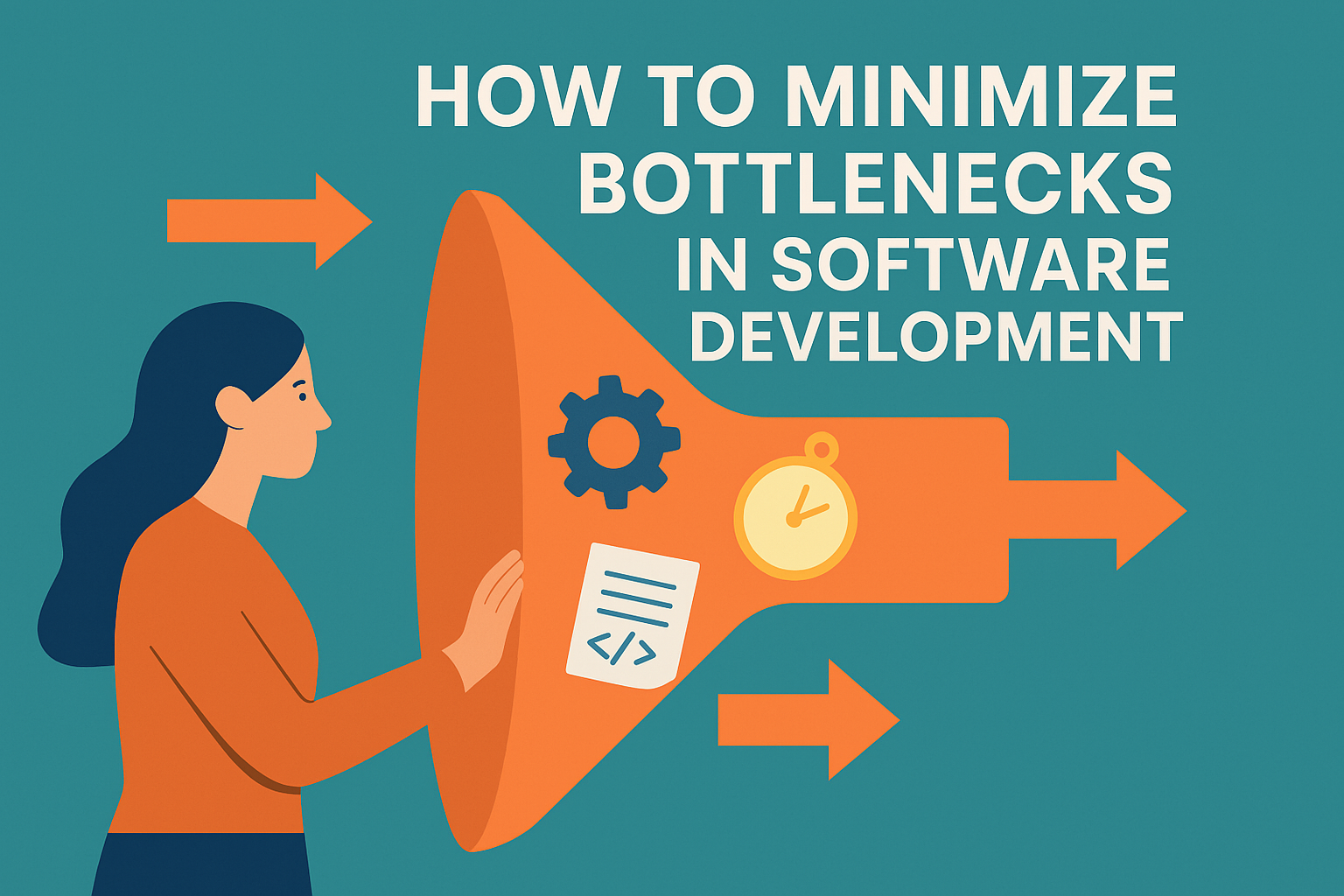How to Minimise Bottlenecks in Software Development

Bottlenecks in software development are more than just productivity killers - they’re silent disruptors of momentum, morale, and value delivery. They slow teams down, introduce frustration, and create friction between intent and execution. Left unchecked, they compromise the very agility we strive for in modern engineering organisations.
To deliver high-quality software at speed, teams need to actively identify, address, and prevent bottlenecks across the entire delivery lifecycle - from ideation to production. The goal isn't just to remove blockers, but to optimise flow, increase clarity, and create an environment where work moves smoothly and teams can thrive.
In this article, we explore the causes of bottlenecks, how to spot them, and - most importantly - how to minimise them for sustainable delivery.
What Is a Bottleneck?
A bottleneck is any point in your software development process where flow is constrained, delayed, or stopped altogether. It’s where work piles up, waits too long, or requires repeated intervention. Bottlenecks can occur at any level:
People: A critical person is overloaded or decisions are dependent on a single individual.
Process: Manual steps, approvals, or unclear workflows slow down progress.
Technology: Long build times, flaky tests, or infrastructure issues introduce drag.
Communication: Misalignment between teams causes rework or delays.
Bottlenecks aren’t just inconvenient - they create systemic drag. And over time, they reduce throughput, increase costs, and demoralise teams.
How to Identify Bottlenecks
The first step in minimising bottlenecks is knowing where to look. Useful techniques include:
🔍 Value Stream Mapping
Visualise the end-to-end flow of work. Identify where time is spent waiting, where feedback loops are long, or where handoffs create delays. Look for steps with the longest cycle times or the most variability.
📈 Delivery Metrics
Track indicators such as:
Lead time for changes
Work in progress (WIP)
Cycle time
Change failure rate
Blocked issues in your backlog
Patterns will point to specific areas of friction.
🎯 Retrospectives and Feedback
Listen to your teams. Engineers often know where the pain is - they just need space and safety to voice it. Retrospectives and feedback loops help surface recurring issues that may not show up in dashboards.
🚦 Flow Efficiency Audits
Analyse how much time work spends in an “active” vs “waiting” state. In many teams, most time is lost between tasks - not during execution.
Strategies to Minimise Bottlenecks
Once you know where your bottlenecks are, you can start addressing them. Here are proven strategies:
✅ 1. Reduce Work in Progress (WIP)
Multitasking spreads focus thin and causes context switching. Limit the number of tasks in flight to reduce cognitive overload and improve throughput. Kanban boards with WIP limits help reinforce this discipline.
✅ 2. Automate Repetitive Tasks
Manual steps - like deployments, testing, or code formatting - can be major time sinks. Automate wherever possible to remove friction and free engineers to focus on higher-value work.
✅ 3. Invest in CI/CD and Tooling
Slow builds, flaky tests, and unreliable pipelines are classic tech bottlenecks. Invest in build performance, parallel testing, and fast feedback. A 10-minute build might feel fine - until you’re running it 30 times a day.
✅ 4. Clarify Ownership and Decision-Making
If work stalls waiting for decisions, clarify who can make what call. Empower teams to act within defined boundaries, and reduce dependency on senior leadership for tactical decisions.
✅ 5. Shift Left on Requirements and Testing
Unclear requirements and late-stage testing introduce rework and delays. Involve engineers early in discovery, and embed testing into development cycles. Quality should be built in, not inspected later.
✅ 6. Encourage Cross-Functional Collaboration
Cross-team handoffs are often slow and prone to miscommunication. Form cross-functional squads with shared goals and end-to-end responsibility to reduce waiting and increase alignment.
✅ 7. Make Bottlenecks Visible
Transparency drives accountability. Use dashboards, kanban boards, or burn-up charts to make delays and blockers obvious. Celebrate when teams proactively resolve them.
Cultural Enablers: Beyond Process
Minimising bottlenecks isn’t just a process issue - it’s a culture issue. Teams need:
Psychological safety to raise concerns without blame
Continuous improvement mindset to adapt processes over time
Supportive leadership that values flow over control
Time and permission to fix what’s broken - not just deliver features
The best engineering cultures don’t chase velocity - they pursue sustainable pace and systemic flow.
Key Takeaways
✅ Bottlenecks reduce delivery speed, team morale, and business agility.
✅ They can be found in people, process, technology, or communication.
✅ Value stream mapping and delivery metrics help identify the root causes.
✅ Reducing WIP, automating toil, and empowering teams are key to removal.
✅ Culture is critical - minimising bottlenecks requires psychological safety and continuous improvement.
Final Word
Engineering excellence isn’t about how fast teams can go in the best-case scenario - it’s about how smoothly and predictably they can deliver value in the real world.
Minimising bottlenecks creates a delivery environment where engineers can flow, not fight. Where work is frictionless, not fraught. Where time is spent building great software - not waiting for the system to catch up.
Because when bottlenecks are removed, potential is unlocked - and that’s when the real magic happens.
Engineering leader blending strategy, culture, and craft to build high-performing teams and future-ready platforms. I drive transformation through autonomy, continuous improvement, and data-driven excellence - creating environments where people thrive, innovation flourishes, and outcomes matter. Passionate about empowering others and reshaping engineering for impact at scale. Let’s build better, together.
